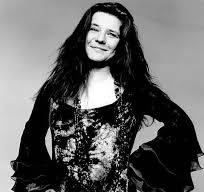JANIS JOPLIN; Her Pain And Her Pride
JANIS JOPLIN; Her Pain And Her Pride
by Norman Warwick

Olivia Abbercrombie, one of a loing line of excellent writers for the excellent Past magazine ,Janis Joplin’s curse was that she was always going to stand out—for better or for worse. From her unstoppable on-stage energy outshining her Big Brother and the Holding Company bandmates to seeing her creativity become alienated at the conservative Thomas Jefferson High School in Port Arthur, Texas, she was always going to be different. My grandpa graduated high school with her in 1960, and he always told me, “Janis was strange, but we knew she was going to do something big with her life.” It seems like a lot of the ridicule Janis endured growing up was jealousy from those who preferred following the path before them rather than paving their own. Her curse weighed heavy on her heart, and she released so much of that pain into her music and, unfortunately, the drug habit that led to an early death at the age of 27. In her short life, however, she gave us incredible works with Big Brother and the Holding Company, and what is deemed by many as her best work in Pearl—yet I Got Dem Ol’ Kozmic Blues Again Mama! is where we got more than just a piece of her heart, we got her radiant soul.
That album has been chosen as the second in a series of Time Capsules, following Live At The Old Quarter by Townes Van Zandt in a new Saturday series by Paste on-line magazine.
After spending three years with Big Brother and the Holding Company, making hits like “Piece of My Heart” and creating historic performances like the band’s turn at Winterland Ballroom in 1968, Janis felt the veil of complacency slowly descending upon her bandmates. Every night was starting to blend together, and after mostly kicking her drug habit, watching them indulge every night wasn’t a part of her artistic vision. She had big plans for herself, and a mundane routine wasn’t one of them.
In the summer of 1969, she began recording her first solo album, I Got Dem Ol’ Kozmic Blues Again Mama!, with dreams of creating a grand sonic atmosphere that could lift the power of her voice and nurture her blazing energy. Finally, on her own, she started to lean toward the inspirations that made her love music in the first place.
Growing up in the local First Christian Church choir and surrounded by music from a younger age—because of her mother’s past as a singer and her father’s love of classical music—Joplin always looked to music for comfort. In school, she was teased for her weight, having acne and holding liberal-leaning political views—a period which haunted her throughout her life. She was a deeply sensitive soul, and the hatred from her peers fostered insecurity even after she became famous. While Janis is often labeled the queen of psychedelic rock, her soul lies with the blues legends who raised her. Back in Port Arthur, she found solace in a group of boys who introduced her to the likes of Bessie Smith, Lead Belly and Ma Rainey—where they found these R&B records in a small conservative southern town, I’ll never know, but without them, we may have never be graced with the greatness that is Janis Joplin.
Joplin’s big plans of having an all-star backing band weren’t entirely executed on I Got Dem Ol’ Kozmic Blues Again Mama!. Still, even with the lack of fluidity of the record’s instrumentals, she could squeeze out every masterful note and dominate this album in a way she never could with Big Brother—because it was her, front and center. All the years she spent studying the great blues singers led to an explosion of creativity that became her debut statement. It’s far from perfect, arriving messy, loud and all over the place—but isn’t that exactly who Janis was?

Still, both then and now, people saw I Got Dem Ol’ Kozmic Blues Again Mama! as a trial run for the masterclass that would become Pearl, yet there is an undeniable spirit in Janis Joplin’s solo debut that sounds like she was finally finding her place. This was her do-or-die moment, having left behind her successes with Big Brother and the Holding Company because she wanted to create something Bessie Smith, Billie Holiday and Big Mama Thornton would have been proud of. She felt weighed down by her past band’s psychedelic sound and wanted to bring a more complex approach to her own, but the shift from the hypo-rock that propelled her to stardom to a soulful R&B tapestry was not received too kindly. Where did the rugged psych-rock goddess go? Nowhere. She was just finally free to explore her blues roots and gave us a record that was all Janis. The spirit of her music ancestors was laced throughout the 26-year-old’s solo debut—an eight-song tracklist full of jazz licks, southern roots and bottomless gospel influences. It was a portrait of her short but undeniably vibrant life.
Initially met with a lukewarm reaction by critics expecting the psychedelic prowess of her former performances, I Got Dem Ol’ Kozmic Blues Again Mama! found some praise from Rolling Stone—largely on account of Joplin’s singing chops. While the ambitious spirit of Joplin explodes out of the record with an infectious energy, the album suffers due to the rush of Columbia wanting to get it out while still riding the high of Big Brother and the Holding Company’s Cheap Thrills. The instrumentation suffered from haste, but contrary to many critical opinions, there is still much of the musicality to enjoy, such as the incredible guitar work by Paul Butterfield Blues Band axeman Mike Bloomfield. However, as always, it’s Janis’ voice that is the star of the show.
Janis Joplin sang with more than just her voice, though. She sang with every fiber of her soul. After years of being weighed down by the cosmic might of the Holding Company, she needed to break free to truly let her voice unwind—and her voice was as vulnerable as it was tough. The persona and personality Janis carried, too, mimicked this dichotomy; outwardly, she was a bluesy spitfire, always cradling a bottle of Southern Comfort, but on the inside, she only craved acceptance and adoration. Yet, without those dueling forces within, she would never have been the star she became.
Her fierce rasp blares over a chugging beat on “Try (Just a Little Bit Harder),” the album’s opening track, packed with a big band energy competing with the sonic force that is Janis Joplin’s mezzo-soprano vocals. The background harmonies from Sam Andrew and Snooky Flowers on this track are laughable at best and, if anything, they could have tried a touch harder to hammer the beauty home. Though this is the weakest song on the album—which is tough, considering it’s the introduction—it still blazes with Joplin’s electricity, drawing you into the rest of I Got Dem Ol’ Kozmic Blues Again Mama! like a firecracker going off. In a flash, we are gifted with one of the most inconceivably marvelous rock vocal performances ever on “Maybe,” a creative re-arrangement of the Chantels’ doo-wop song original. It’s a beautiful display of the deep pain Joplin could access through her voice, as she drags us through the mud—bringing out emotions I could never access without her kaleidoscopic voice to guide me through.
The Texas darling brings us all the way home on “One Good Man,” opening with the sting of a gospel-inspired organ from Richard Kermode and a wailing riff from Bloomfield. We are transported right under the burning Southern sun, as the fire of “One Good Man” finds Janis fighting with the guitar licks as much as she fights with herself. This was the only track on the album she wrote completely solo, and the narrative displays the raw honesty she was capable of but didn’t always step into the limelight to show off. The world knew her as a rambunctious, wild child who did whatever she wanted without hesitation but, deep down, she was at war with herself and her desire to live a “proper” life. Growing up in Texas painted a picture of blue skies, white picket fences and a man coming home to you at night. That is how Janis Joplin grew up, after all. “Honey, I love to go to parties / And I like to have a good time / But if it gets too pale after a while / Honey and I start looking to find / One good man,” she cries out on “One Good Man,” digging up the repressed, forgotten desires of that little Texas girl who once just wanted to fit in.

We’re then met with a stretch of the band playing around with funky grooves before Joplin’s voice cuts through to deliver an onslaught of wails and vibrato, showing off her massive voice. “As Good As You’ve Been To This World” is essentially a big jam session with Joplin riffing over the top. It’s a bit of brassy fun before you are blasted with an aching bluesy version of the Bees Gees’ (left) “To Love Somebody.” Joplin’s effort recalibrates it from a pop ballad into a soulful rocker, adding a new level of heartache to an already vulnerable track. “To Love Somebody” picks up pace during the chorus, aiding Janis’s belting, and slows down to let her air out her softer side—though still not lacking in her distinctive rasp.
The album’s sixth track cracks open with melancholic keyboard flourishes from Kermode, Gabriel Mekler and Goldy McJohn before Joplin’s voice slashes through it, crying, “Time keeps moving on / Friends they turn away / I keep moving on / But I never found out why.” “Kozmic Blues” is the only other track Joplin wrote on I Got Dem Ol’ Kozmic Blues Again Mama! (alongside Mekler), and it makes me once again wish we had gotten more of that raw, unedited pensiveness on the album (and in her career altogether, as she’d only write two songs again on Pearl). When her personal stories connect with the ache of her skyscraping rasp, a different kind of tangible, electrocuted magic happens.

While Janis Joplin had a talent for pouring her own emotions into other people’s words, like that of Nick Gravenites and Kris Kristofferson and Bobby Womack, it’s special to hear language burst out of her with liberation. To this day, it floors me that “Little Girl Blue” wasn’t written by Joplin, as it has that sorrowful yearning for acceptance and love that she captures so perfectly in her short discography. The original writers’ (Broadway composers Lorenz Hart and Richard Rodgers) story might as well be her own—an insecure outsider with a tendency to self-medicate using booze. Her version of the theater classic displays a balance of empathy and catharsis, almost as if knowing other people felt uncomfortable in their own skin, too, helped ease her grief.

Joplin was an unstoppable force—always craving more from life—and “Work Me, Lord” is the culmination of all those years of strife, pain, addiction and yearning for belonging poured into a six-and-a-half-minute purgative finale. Janis’s one fundamental flaw was that she could never sit still—because she would never be content, no matter how well she did. “But I don’t think you’re going to find anybody / Not anybody who could say that they tried like I tried / The worst you can say all about me / Is that I’m never satisfied,” she confesses, over a soaring brass symphony (executed by Terry Clements, Snooky Flowers and Luis Gasca) the way she always dreamed. Look to I Got Dem Ol’ Kozmic Blues Again Mama!
You’ll find a blueprint for boisterous female rock leads like Liz Phair, the Wilson sisters, Cat Power, Fiona Apple (right) and so on. Janis Joplin’s staying power will never fade away and, at the end of the day, she was just a girl trying to find herself in a world that couldn’t quite hold her style. Little did she know, she was in the right place all along.
acknowledgements
The primary sources for this piece was published by Paste in print and on line media Authors. Other sources have been attributed in our text wherever possible.
Images employed have been taken from on line sites only where categorised as images free to use.
For a more comprehensive detail of our attribution policy see our for reference only post on 7th April 2023 entitled Aspirations And Attributions.




Leave a Reply
Want to join the discussion?Feel free to contribute!